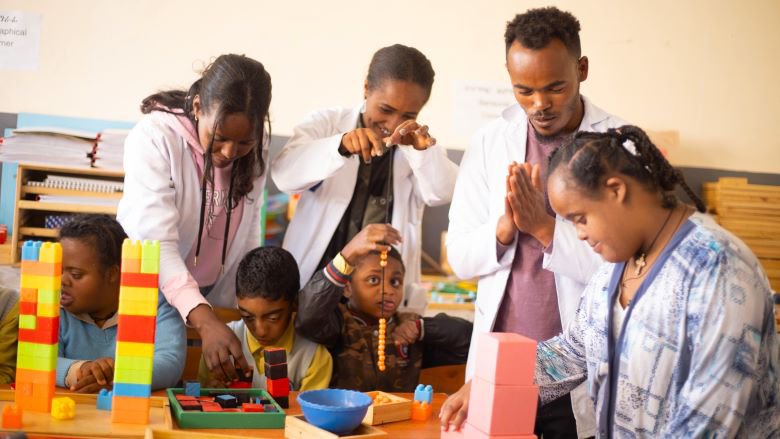12-year-old Mariamawit’s* life was changed forever by a hearing assessment conducted at a government-established inclusive education resource center (IERC) that supports learners with disabilities in Addis Ababa.
Since grade 3, Mariamawit, who has hearing loss, was misdiagnosed as having an intellectual disability. She was placed in a classroom with similar peers where she remained mostly non-verbal because she was simply not able to hear. A visiting special education expert sensed something was awry and sent Mariamawit for a reassessment, where her hearing loss was correctly diagnosed. That was the beginning of her new life. With the help of hearing aids, Mariamawit swiftly moved up grades and is now thriving as a high school student in Addis Ababa.
Mariamawit’s life transformation attests to the success of inclusive education reforms of the Government of Ethiopia, also part of the multi-donor-funded General Education Quality Improvement Program for Equity Program (GEQIP-E), which expands and strengthens inclusive education for children with disabilities across Ethiopia. As the world grapples with the worst education crisis in history, Ethiopia’s reforms in educating children with disabilities stand out as a beacon of hope for inclusive education across the country.
The student enrollment numbers confirm the success of the government’s ongoing efforts: more than 91,000 children with disabilities have joined 753 IERCs supported by the program as of June 2022. An additional 264 IERCs were established so far in 2023, bringing the total number of such centers across Ethiopia to 1,017, as compared to 113 in 2017. This is in line with the Comprehensive Education Sector Development Program (ESDP VI) that the government has laid out for 2020/21 - 2024/25.
Yohannes Wogaso, Lead Executive Officer for educational programs and quality improvement at the Ministry of Education in Ethiopia explains the government’s vision with GEQIP-E. “The Government of Ethiopia considers education not only as a weapon to escape poverty, but also to fight poverty. In the last three decades, the government has ramped up its efforts to improve education and, has allocated 23% of the country’s public expenditure to education, with the last four years spent on addressing the gap in quality and equity.”
As Ethiopia embraced the challenge of expanding its education system to include the previously marginalized, it had to take a multi-pronged approach to designing, creating, and implementing inclusive education. It was no small endeavor that required getting buy-in from communities, changing social norms, setting up dedicated and adequately equipped resource centers, and training teachers in the principles of inclusive education. Here is how it all happened.
Inclusive Education Resource Centers (IERC) became the epicenter of assessment and learning
The IERC model was critical to realizing the vision of educating children with special needs across Ethiopia. Consider the IERCs main cluster schools that other neighborhood or satellite schools seek out for help—from tapping into the expertise of teachers who are specially trained to work with children with special needs (called itinerant teachers), to hosting community discussions and serving as the central repository for educational materials and assistive devices. IERCs are also responsible for early identification and assessment of children so that years are not shaved off a child’s education and the right interventions are provided for optimal learning and development.
As itinerant teachers from the state of Oromia put it, “The realization that education of children with disabilities is a human right came along with the opening of the IERCs.” Mariamawit’s case above speaks volumes for the necessity of IERCs.
Askale Wolde-Giorgis, an itinerant teacher at the Bole Arabsa kindergarten and primary school in Addis Ababa, says, “The IERC has brought positive change for our school. It has helped students understand how to use the materials, and the best thing is that the students have been able to get out of their houses and be able to use it.”



